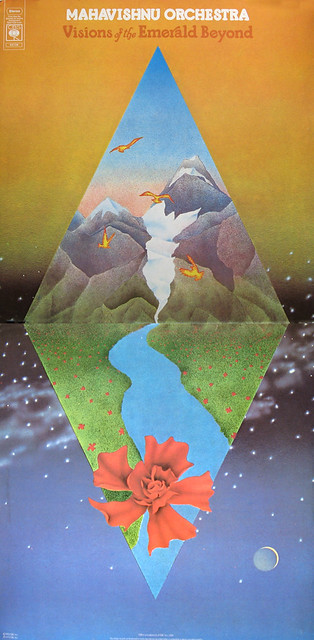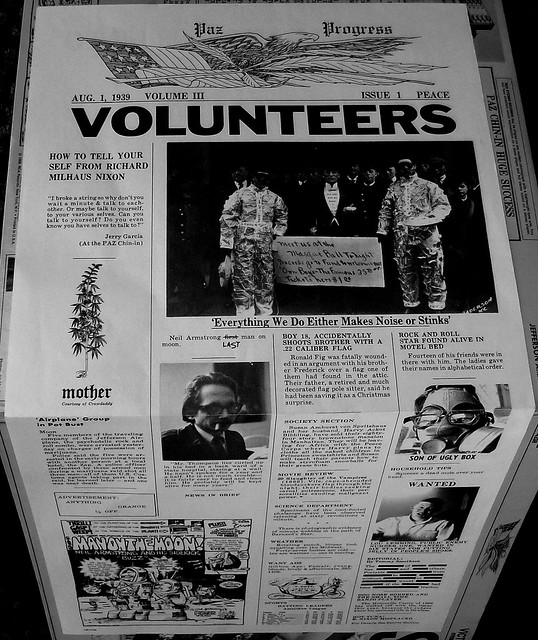
If you really want to get into the spirit of Record Store
Day, squeeze through the used aisles and pick up a few gatefolds. These
oversized works of mass-produced art are the quintessential vinyl experience.
They say you can’t roll a joint on a digital download. But you
can eat an entire midnight munchies meal
off of an open gatefold. And many of them are cheap cheap cheap. Some of my
favorites were a mere $2.99. Like the three
Carole King albums I own,
Tapestry,
Music, and
Rhymes
& Reasons. All together they cost me less than the price of a good
sandwich, and they’re classic specimens, especially the latter two: great big
pictures of Carole at a grand piano with her husky at her side and sunlight
warming through the window; soft close-ups of her smiling and lost in thought.
They’ve got a matte finish with a linen texture that feels nice on your
fingers. It’s intimate, like you’re in Carole’s house and sipping tea as she
sings to you. And I’m not ashamed to say I love Carole King, gatefold or no. I
was a little kid when her music was everywhere and it couldn’t help but shape
my mind and soul. “So Far Away” gets me every time, even when
Johnny Rivers sings it, which he does
quite well on
Home Grown, his best, in my opinion. Here the guy who sang
“Secret Agent Man” goes on a jag through sunny early 70s commune-esque
spirituality. This record also comes in a gatefold. Another matte finish, faux
linen, but with lots of pictures of Johnny with a bushy beard, smiling, in
meadows full of tall grass and flowers. He sings the hell out of some of the
best songs of that era – “Our Lady of the Well,” “Rock Me On the Water,” “Fire
and Rain.” Just a gorgeous record.

Some
classic gatefolds don’t qualify as low-hanging fruit because they’re expensive,
such as the
Rolling Stones’
Their
Satanic Majesties Request, arguably the greatest album cover of all
time, at least for people who have taken a lot of acid. A 3D photo of the band
in wizard costumes is not easily topped. Inside is a maze and a crazy collage.
I got my copy for 70 bucks in Atlanta – the exact same pressing of the one I
got for Christmas my junior year in high school, brand new in the shrink-wrap.
Probably cost $10 back then. No, what we’re interested in here is art for the
poor man:
Santana’s
Caravanserai
– big orange sun over a dark blue sky and desert and camels, inside a
gloriously blurry sunset over the ocean;
Allman
Brothers’
Eat A Peach – peaches
and melons the size of truck beds on the front and back, opens to a vast
panorama of Magic Mushroom Land;
Mahavishnu
Orchestra’s
Visions of the Emerald Beyond – mirrored pyramids that rise lengthwise, up and down, one to
sunrise, the other to night;
Gentle
Giant’s
Acquiring the Taste looks
like a tongue licking an ass until you open and see it’s just a delicious
peach; and all those
Yes covers by
Roger Dean, especially
Close To the Edge, which is their
best musically, too (even if you hate Yes you should own a Yes/Roger Dean
gatefold, it’s an obligation of the hobby). There are so many.

And if a
gatefold isn’t enough, there are double gatefolds, too, and gatefolds with
inserts, booklets, and records that aren’t even gatefolds, they just have odd
shapes, like
The Low Spark of High Heeled Boys and
Shoot Out at the Fantasy Factory by
Traffic, which have
two corners cut out and the art is an optical illusion of a 3D box that looks
very real if you stare at it long enough. This kind of super packaging is
generally the domain of superstars like
Elton
John,
Jefferson Airplane,
Harry Nilsson,
Joni Mitchell, artists with big budgets and a fondness for excess.
After
Nilsson Schmilsson, Nilsson was
all gatefold for the rest of the 70s.
Pussy
Cats and
Duit On Mon Dei are both
triple folds with lyrics on one spread and on the other, collages of snapshots
taken during the making of the album, both of which appear to have been
outrageous parties. Mitchell uses the double gatefold for her underrated tour
de force
Mingus to give it more of an art book feel, with her paintings
of Charles in fields of white with delicate lines of text here and there. But
few can top Elton and the Airplane (and still qualify as low-hanging fruit). Their more elaborately packaged albums are like mixed-media happenings you can
hold in your very hands. Elton’s albums have a Hollywood flair.
Tumbleweed
Connection comes with a twelve-page sepia-tone booklet full of 19
th
Century old West etchings - trains and riverboats and guns, shots of Elton and
his band and lyricist brooding dramatically.
Goodbye Yellow Brick Road folds out three ways like one of those
reflective things people used to hold up across their chests to get a darker
tan. All the lyrics are splayed across in all different colors and each one has
its own little illustration, like those old time movie posters with drawings of
the actors and the most dramatic scenes. And the whole concept of
Don’t
Shoot Me I’m Only the Piano Player
is a night at the picture show. The cover shows a couple buying tickets at
a theater with album’s title across the marquee. Inside, on the left panel, the
song titles and album credits are laid out just like a movie poster, and on the
right is a big picture of Elton holding his hand out like a stop sign. It’s all
colorized and cool looking, and so are all the other photos in the booklet it
opens up to. Page after page of groovy cool-colored pictures. It’s just a
wonderful artifact. I think mine cost $4. And Jefferson Airplane.
Volunteers and
Bark: two of the
best covers ever made, and both relatively inexpensive.
Bark comes in a paper bag with JA printed on the front, just like
the old A&P logo. Open it up and on the other side are freak-comic
portraits of the band in thick-black ink. The bag is folded over a standard
record cover with picture of a dead fish wrapped in paper and tied in string
with a bow. And inside is a fold-open lyric sheet printed in red and black, and
on the back is a list of things you can do with the bag. A long list and, as
you might imagine, some of the suggestions are quite unusual. I love this
record, even though it’s not the record I reach for when I want to really
listen to the Jefferson Airplane (I play it when I want to hear early, very
well done hard rock). When I want the Airplane in its fullest revolutionary
glory, it’s gotta be
Volunteers,
a Woodstock-era masterpiece with the freakiest and coolest mega-gatefold of all
times. It’s done up like a newspaper published in Mescaline Land, with phony
stories and lots of pictures. It has so much going on, you can stare it for
hours. And that’s really what the gatefold is all about – sitting and staring
and listening, slowing down, paying attention, making an event out of a
collection of music. And isn’t that precisely what we celebrate when we
celebrate RSD?

 The
album's other long songs go in different directions as well. "Hits of
Sunshine" is dedicated to the then-recently departed Allen Ginsberg and is
appropriately rambling, jammy and poetic, the perfect tribute to the poet who
bridged the gap between the beats, hippies and punks. Lee Ranaldo's "Karen
Koltrane" is another long rambler, but with the atmospheric noise that has often
characterized Ranaldo's contributions to the band. The album concludes
with a pair of quiet yet catchy numbers. Moore's "Snare, Girl" has a
light, bouncy feel. Gordon closes things out with the soaring "Heather
Angel." A Thousand Leaves
may not have the reputation of Sonic Youth's better known works, but it is every
bit as good and a reminder of just how amazing this band could be. Though
they may be done, Ranaldo's recent solo album and Moore's Chelsea Light Moving
project prove the members are still making engaging, challenging music.
And their catalog is full of excellent albums to explore and
experience.
The
album's other long songs go in different directions as well. "Hits of
Sunshine" is dedicated to the then-recently departed Allen Ginsberg and is
appropriately rambling, jammy and poetic, the perfect tribute to the poet who
bridged the gap between the beats, hippies and punks. Lee Ranaldo's "Karen
Koltrane" is another long rambler, but with the atmospheric noise that has often
characterized Ranaldo's contributions to the band. The album concludes
with a pair of quiet yet catchy numbers. Moore's "Snare, Girl" has a
light, bouncy feel. Gordon closes things out with the soaring "Heather
Angel." A Thousand Leaves
may not have the reputation of Sonic Youth's better known works, but it is every
bit as good and a reminder of just how amazing this band could be. Though
they may be done, Ranaldo's recent solo album and Moore's Chelsea Light Moving
project prove the members are still making engaging, challenging music.
And their catalog is full of excellent albums to explore and
experience.


















